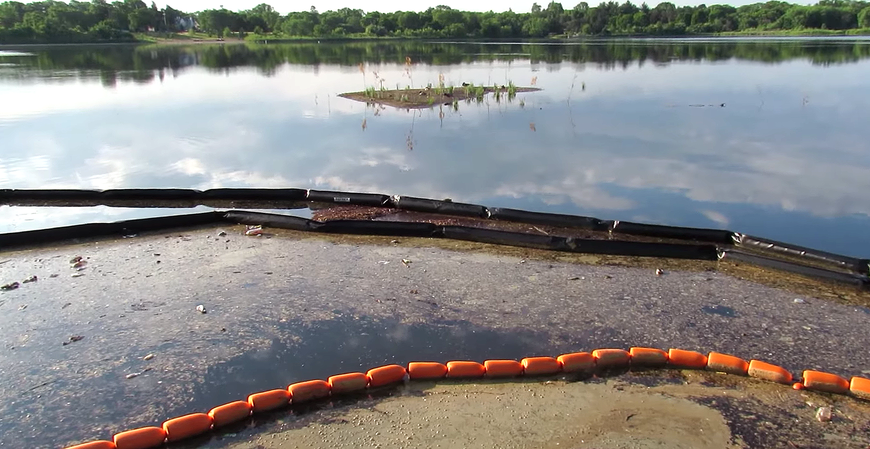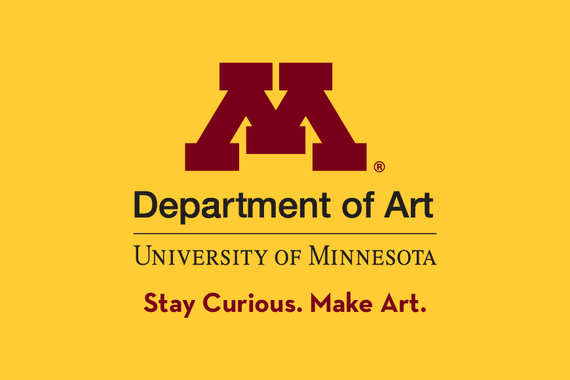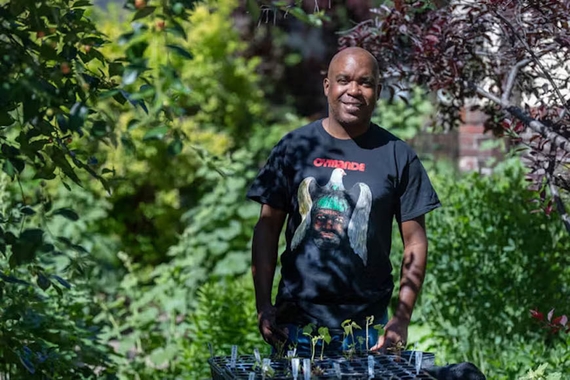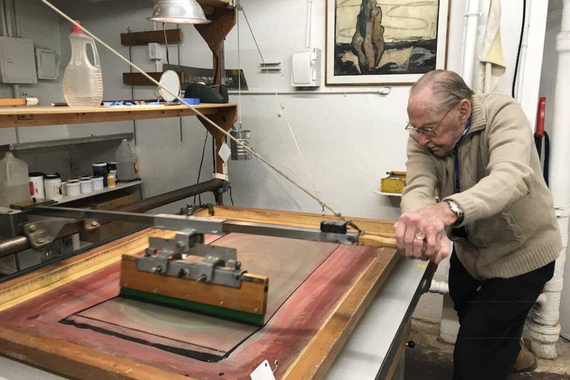The Art of Ecological Renewal
For the past eight years, a large portion of artist and Lecturer Sean Connaughty’s life has centered around garbage. In addition to his own art practice and teaching schedule, Connaughty helped organize Friends of Lake Hiawatha, a volunteer group that has spent countless hours collecting and documenting trash that has gotten washed into the lake from the larger city and suburbs upstream via the storm sewer system. Since forming in 2015, they have removed some five and a half tons of trash — mostly in the form of small, single-use plastics.
On a sunny Saturday in early June, Connaughty and some of his Art + Ecology students got to celebrate a small victory: a three-stage boom was installed to capture the trash at its source, before it is able to float further into the habitat. So far, three weeks and at least one major rainstorm later, the boom appears to be working.
It’s not alone, though. On a raised sandbar of sediment just past the third boom, a spiral pattern of freshly-planted willow cuttings and native plants pokes out of the ground — the final collaborative project of Connaughty’s Art + Ecology class, what they call “the Living Catchment.”
Designed over the course of the semester, the Living Catchment acts as a natural fourth layer of filtration for the stormwater flowing into Lake Hiawatha (Bde Psin), catching and reducing the excess phosphorus, which comes from organic and agricultural waste and can cause algae blooms. At least, that’s the plan. The lake’s other residents might have different plans.
“We had beavers cut down our trimmings, and ducks who were eating our freshly planted reeds,” laughs student Ashley Thilmony, an art major and psychology minor. “We had to adapt and replant each time. We ended up using chicken-wire garters for each plant. Right now we’re seeing what takes.”
Sitting on the lakeshore watching the boom being installed by workers in kayaks, Thilmony’s hands are still dirty from a planting project that morning, helping to place more native flora along Lake Hiawatha’s edge. Other volunteers had participated in the weekly Saturday trash pickup, and several piles of their haul were spread out on tarps nearby. The boom was made possible through a partnership between St. Paul-based Freshwater Society and Alabama-based Osprey Initiative, paid for by a grant from the Coca-Cola Foundation, one of the primary brands creating the plastic pollution that has been found and cataloged by the Friends of Lake Hiawatha. If all goes as planned, Connaughty and his band of volunteers will be able to put that energy elsewhere, as Osprey takes over the periodic emptying of the booms.
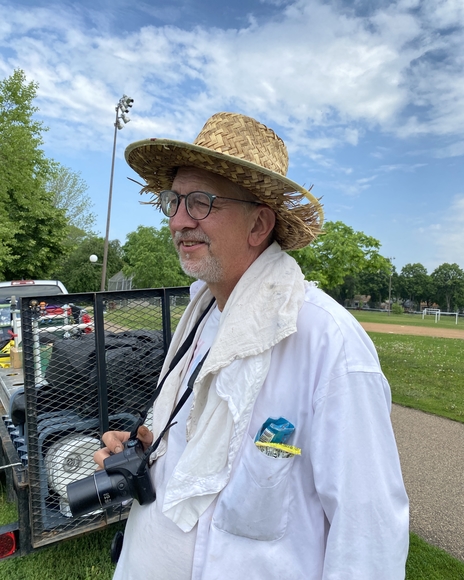
“It is a small victory,” says Connaughty of the boom installation. “And that the Park Board let us do our work in planting.”
Art + Ecology might not be two subjects you would expect to go hand-in-hand, but in Connaughty’s classroom, artists and scientists seem eager to feed off each other’s expertise.
“In the class, we had a lot of diverse major declarations,” says Thilmony. “Three fishery and wildlife majors, a couple psych majors, several undeclared people, and definitely a lot of people from the STEM fields. Even some Math majors because the class piqued their interest and gets them outside and concerned about the ecology. We all share this world.”
In a cynical world dominated by screentime, Thilmony says, “This class was a very necessary refreshment for me.”
In the Classroom
Back in April before the semester ended, the classroom itself was like any other you might find in the Regis Center for Art: artworks large and small line the walls, students sit on the floor weaving sculptures, groups break off to discuss collaborative projects. But on the chalkboard, they have a list going like they’re managing a landscaping business: Pussy Willow (18 plants), Northern Blue Flag (18 plants), Common Rush (72 plants), and so on. The large posters show elements of painting, drawing, and collage, each one illustrating issues related to invasive species, biodiversity, and habitat management.
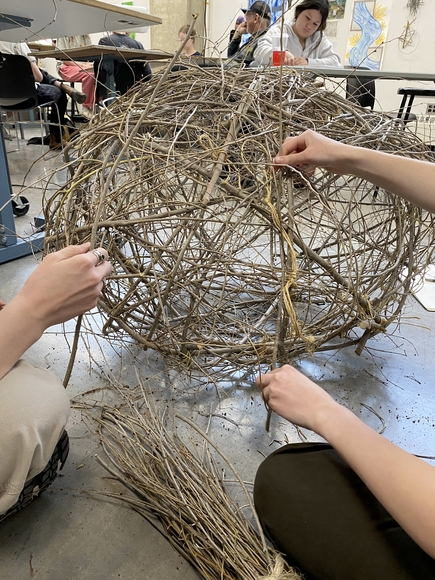
The class has covered art history, indigenous knowledge, and even the less glamorous side of community activism — presenting your plan to local government boards. “We've been hearing a lot about Sean's experiences with communicating with multiple entities and engaging with community,” says art MFA candidate Anna Clowser, who is investigating local histories through digital collages in her own work. Working towards the Living Catchment, Clowser explains, “we get together and do research on what sort of plants are good for this environment and the possibilities of what we could install in this space. I see this project as an intervention. More than anything, it’s become about educating the public and how installing this brings attention to what’s happened.”
Down on the floor, weaving Siberian Elm branches into a large orb, two non-art majors reflect on what this class has meant to them. “It has been good to help expand my points of view,” says Hailey Rhoades, a Plant Science major. “In order to create any sort of change — environmental change, social change, just in general — I think you have to set up a pleasure in that pursuit. Art is a great way to get people to engage in a way that doesn't feel like they're doing work.”
At this point, Connaughty comes back into the classroom carrying a familiar item: a half-full black garbage bag. “Anyone else want to use trash collection in their projects?” he asks the room. He gets a couple of enthusiastic takers.
“He’s one of my favorite professors I’ve ever gotten to work with,” says Rhoades.
Art + Ecology in the Fall 2023
With this semester winding down and the Living Catchment installed, Art + Ecology in the fall semester will turn to Professor and environmental artist Christine Baeumler, assisted by Maria Park, a PhD student in the Department of Ecology, Evolution, and Behavior (who is also a practicing artist). Similarly to Connaughty’s course, Baeumler’s class engages with place-based and experiential learning while exploring issues of environmental justice. In the fall of 2022, Baeumler’s class began a project at the Riverside Plaza with Metro Blooms, an organization that “partners with communities to create resilient landscapes and foster clean watersheds, embracing the values of equity and inclusion to solve environmental challenges.” Metro Blooms initially worked with residents of the Riverside Towers to design a pocket park on Cedar Avenue. The fall 2022 Art + Ecology class visited the site with Metro Blooms staff and developed concepts integrating art and interactive features into the pocket park design, focusing on the theme of pollinators. Those concepts were reviewed and approved by community members, and next semester the Art + Ecology course will pick up that project and work with Metro Blooms and Riverside Towers residents to create and install the artistic elements.
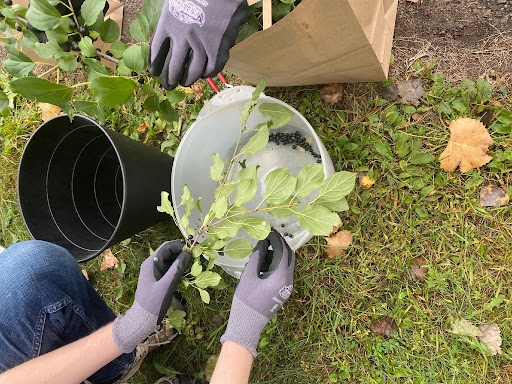
Another hands-on project focused on the impact of buckthorn on water quality in the Mississippi River. The 2022 class learned about the problem from Minnesota Park Board staff and then gathered buckthorn berries, created their own buckthorn ink, and learned about a variety of natural pigments from artist Kim Boustead. Other field trips took the class to the Cedar Creek Long Term Ecological Site to learn about climate change impacts on plant communities and to the Capitol Region Watershed District to see how art can be integrated into storm water management. The end of the course culminated in final art projects inspired by ecological issues, using recycled and other low impact materials to realize their ideas.
It has been said that science is the pursuit of answers and art the pursuit of questions, though truly one cannot exist without the other. Through these interdisciplinary courses, weaving together research, craftsmanship, collaboration, and community, students get the chance to cross-pollinate their interests, expand their understanding of real-world issues, and quite literally get their hands dirty — both in the studio and in the field.
You can read more about the litter-capture boom in the Star Tribune, and Freshwater Society produced a great profile video on Sean Connaughty available to watch on Youtube.



